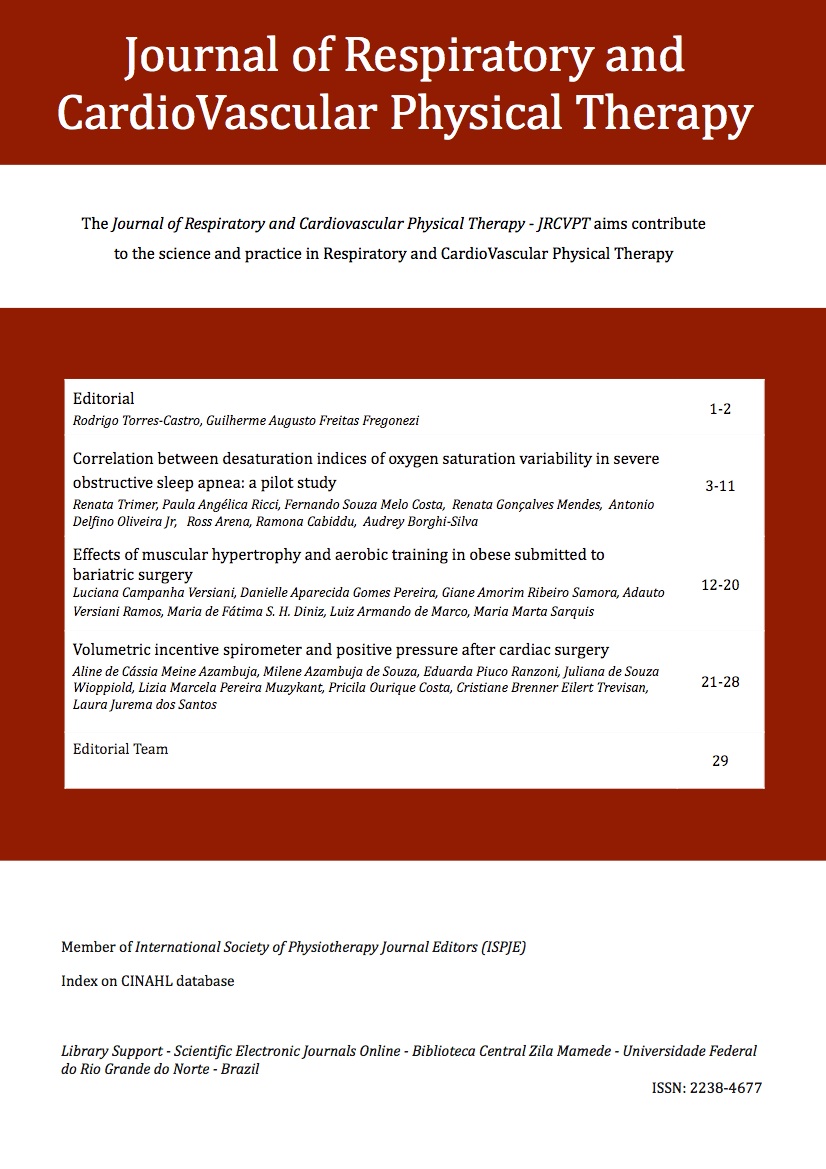Volumetric incentive spirometer and positive pressure after cardiac surgery
Palabras clave:
cardiac surgery, post-operative complications, non-invasive ventilation, positive pressure breathing, incentive spirometerResumen
Background:Most patients that undergo cardiac surgery develop post-operative pulmonary complications. The use of an incentive spirometer associated withpositive end-expiratory pressure (PEEP) and non-invasive ventilation (NIV) may contribute to the reduction of such complications.
Objective: To compare the efficacy of an incentive spirometer associated with positive end-expiratory pressure to NIV in pulmonary complications in the PO of heart surgery during hospitalization in the intensive care unit (ICU).
Methods: A randomized clinical trial conducted from July 2012 to July 2015 at the ULBRA Mãe de Deus University Hospital -Canoas/RS. Patients were randomized into three groups: Group I – NIV; group II - volumetricincentive spirometer (IS) associated with positive end-expiratory pressure (PEEP) (IS+EPAP); and group III - conventional (CG). The three groups received motor physiotherapy. Post-operative monitoring of pulmonary complications was performed through radiology service reports until the time of discharge from the ICU.
Results: 49 patients were included in the study, 13 patients in Group I, 16 patients in Group II and 20 patients in Group III. The average age of Group I was 61.7 ± 10.4 years, 61.4 ± 10.2 years in Group II, and 62.9 ± 11.5 years in Group III. Atelectasis was the pulmonary complication that had the highest statistical significance when comparing the three groups in the immediate PO (p=0.035).
Conclusion: When comparing non-invasive ventilation (NIV) to incentive spirometry (IS) associated with positive end-expiratory pressure (PEEP) or respiratory exercises, we could not conclude that this particular technique is superior in relation to the decrease of pulmonary complications.
Descargas
Descargas
Archivos adicionales
Publicado
Cómo citar
Número
Sección
Licencia
Copyright Transfer Statement
The author(s) of the article, as specified here, hereby transfer(s) to the Revista de Fisioterapia Respirtória e CardioVascular (Journal of Respiratory and CardioVascular Physical Therapy) all copyright ownership rights, title and interests that the author(s) may have or may come to have in and to the article and any revision or version thereof, including, but not limited to, exclusive right to print, publish and sell the article anywhere in the world, in any language and in any media.
This agreement will be considered effective and valid if and when the article is accepted for publication.
If the article contains any copyright-protected material from a third party, the author(s) must obtain written permission to reproduce the said material in the article from the copyright holder and send it to the Revista de Fisioterapia Respirtória e CardioVascular (Journal of Respiratory and CardioVascular Physical Therapy).
The author(s) guarantee(s) the holding of proprietary rights to the article; not having granted or transferred any rights to the article to any other persons or entity; that the article is susceptible to the demand for rights by its author(s); not having infringed upon any author rights, trademark or patent; not having violated the right to privacy or publicity of any person or entity; that the article does not contain any defaming subject; that the factual statements made are true or are based on reasonably accurate research; and, finally, that, the author(s) has/have no reason to believe that any of the formulas, procedures or prescriptions contained in the article will cause damage if used or followed in accordance with the instructions and warnings contained in the article.
The author(s) will indemnify the Revista de Fisioterapia Respirtória e CardioVascular (Journal of Respiratory and CardioVascular Physical Therapy) against any costs, expenses, damages or liability that the Revista de Fisioterapia Respirtória e CardioVascular (Journal of Respiratory and CardioVascular Physical Therapy) may incur as a result of accidental omissions of these guarantees. These representations and guarantees may be extended to a third party by the Revista de Fisioterapia Respirtória e CardioVascular (Journal of Respiratory and CardioVascular Physical Therapy).
Date:
Note: Each author must individually complete and sign this form
1) Author:
Signature: _________________________________
2) Author:
Signature: _________________________________
3) Author:
Signature: _________________________________
4) Author:
Signature: _________________________________
5) Author:
Signature: _________________________________
6) Author:
Signature: _________________________________
7) Author:
Signature: _________________________________
8) Author:
Signature: _________________________________




 English
English Español (España)
Español (España) Português (Brasil)
Português (Brasil) Français (Canada)
Français (Canada)